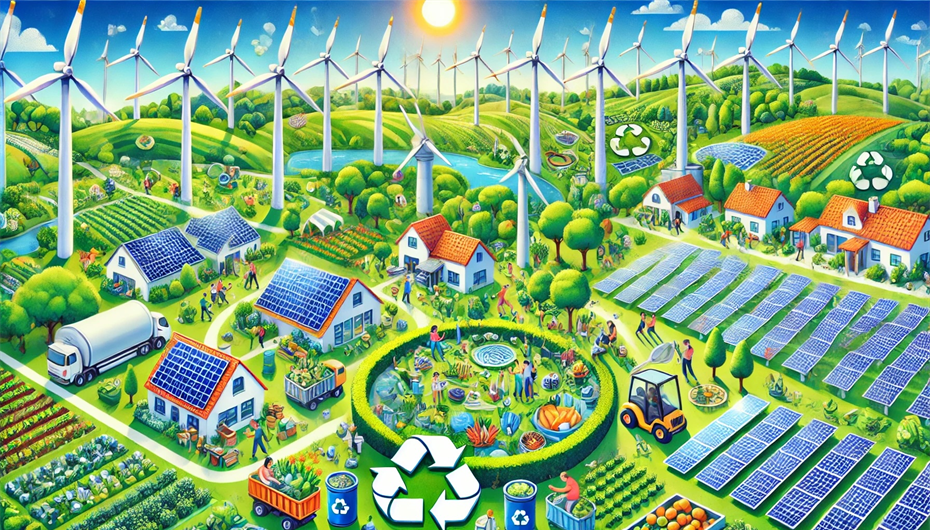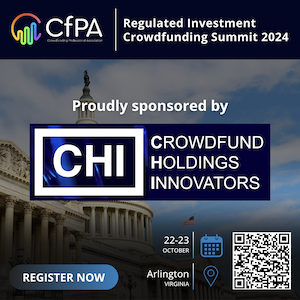Infrastructure development in the United States, particularly in climate tech sectors like wind farms, solar plants, waste-to-energy facilities, or other First of a Kind (FOAK) projects, frequently faces substantial local opposition. This resistance, commonly referred to as "Not In My Backyard" (NIMBY), is driven by concerns over environmental impact, property values, and disruptions to daily life. The resulting delays not only stall project timelines but also threaten the U.S.'s ability to meet crucial climate goals. Slowing the growth of renewable energy projects undermines efforts to reduce carbon emissions and transition to a sustainable energy system.
However, countries like Germany and Denmark have demonstrated an effective solution: community ownership. By allowing local residents to invest directly in infrastructure projects, these nations have transformed NIMBY-driven opposition into widespread support. In the U.S., regulated investment crowdfunding (Reg CF and Reg A) presents a similar opportunity to engage communities, accelerate project development, and help the country stay on track with its climate commitments.
Regulated Investment Crowdfunding in the U.S.
Regulated investment crowdfunding offers a pathway for businesses to raise capital from a broad base of smaller non-accredited investors, including members of the public. Two prominent frameworks enabled by the JOBS Act of 2012 (and revised in March of 2021), “Regulation Crowdfunding” (Reg CF) and “Regulation A” (Reg A), provide issuers with the flexibility to raise substantial sums for projects like renewable energy developments.
- Reg CF allows businesses to raise up to $5 million annually, making it an ideal mechanism for smaller, community-driven projects.
- Reg A, on the other hand, allows issuers to raise up to $75 million annually, facilitating larger infrastructure ventures that require significant capital. Both accredited and non-accredited investors can participate, enabling a wide array of individuals, including local residents, to take part.
Both crowdfunding mechanisms allow companies to streamline their capital structure, with investors appearing as a single line item on the cap table. This simplifies governance while maintaining broad-based community involvement, which is essential for projects seeking to engage and benefit from local investment. Furthermore, there is a great deal of flexibility in the type of security offered (e.g. debt, equity, revenue sharing agreement, Crowd-SAFE, etc.) to the crowd by the company raising funds.
Why Local Ownership Can Overcome Opposition
One of the key drivers of local opposition to infrastructure projects is the perception that negative externalities—such as noise, environmental degradation, or decreased property values—are imposed on the community, while financial gains flow to distant corporations. Regulated investment crowdfunding can shift this dynamic by offering residents a chance to directly invest in the project, thereby aligning their financial interests with its success.
When communities are given an opportunity to co-own these projects, local resistance often diminishes. Individuals become stakeholders with a vested interest in the success of the project, transforming them from passive bystanders into active participants who stand to benefit both economically and socially.
Lessons from Germany: Empowering Communities through Ownership
Germany has been a leader in community-driven renewable energy development, largely due to its decentralized energy model and policies that promote local ownership. One of the cornerstones of Germany's energy transition, or Energiewende, has been the involvement of communities in the ownership and management of renewable energy projects.
Key elements of Germany's approach include:
- Energy Cooperatives: Germany has more than 1,000 energy cooperatives, allowing local residents, farmers, and small businesses to invest in renewable energy projects. By 2020, around 50% of Germany’s renewable energy capacity was owned by individuals or community groups, creating a strong sense of local ownership and support.
- Decentralized Energy Systems: Decentralization enables local communities to generate and manage their own energy, reducing reliance on external providers. This fosters local pride, autonomy, and a sense of control over energy resources.
- Feed-in Tariffs (FiTs): Germany's introduction of feed-in tariffs guaranteed above-market prices for renewable energy, offering predictable returns for community investors. This financial incentive has played a critical role in encouraging community ownership of renewable projects.
Case Study: Feldheim – Germany's Energy Self-Sufficient Village
The village of Feldheim stands as a powerful example of community-driven renewable energy success. Through collective ownership of wind turbines, solar arrays, and a biogas plant, the village supplies all its own energy needs. Residents benefit from lower energy costs, job creation, and reduced carbon emissions, illustrating how community ownership can transform local infrastructure projects into sources of economic and environmental pride.
Denmark: Community Wind Power and Cooperative Models
Like Germany, Denmark has successfully implemented community ownership models, particularly in the wind energy sector. During the 1970s and 1980s, Denmark saw a rise in cooperative wind farms, where local residents pooled resources to co-own and manage wind energy projects. Today, Denmark remains a global leader in wind energy, with community ownership playing a pivotal role in its success.
Key features of Denmark’s approach include:
- Wind Cooperatives: Many wind farms in Denmark are owned by local residents through cooperatives. By allowing everyday citizens to invest in these projects, the country has fostered a culture of shared responsibility and financial benefit from renewable energy.
- Government Mandates for Local Ownership: Danish law requires that at least 20% of shares in new wind projects be offered to local residents. This mandatory inclusion of community ownership has been instrumental in reducing local opposition and fostering public support.
Case Study: Middelgrunden Wind Farm
One of Denmark’s most famous community-owned renewable energy projects is the Middelgrunden Wind Farm, located off the coast of Copenhagen. Half of the wind farm’s 20 turbines are owned by a cooperative of more than 8,500 local residents, offering them a direct financial stake in its success. The project has become a symbol of Denmark’s commitment to renewable energy and local ownership, creating both financial and environmental benefits for the community.
The U.S. Opportunity: Community Ownership Through Crowdfunding
The U.S. has the potential to adopt a similar model of community ownership by leveraging regulated investment crowdfunding. Through platforms operating under Reg CF or Reg A, developers of renewable energy projects can offer local residents a chance to invest, thereby aligning the interests of the community with those of the project.
There are several key benefits to this approach:
- Financial Benefits for Residents: Allowing local residents to invest provides them with potential income streams through project revenues. This can boost local wealth, reduce opposition based on economic concerns, and promote local economic development.
- Engagement and Stakeholder Participation: When community members are directly involved in the project as investors, they are more likely to support its success. Increased engagement also means fewer legal challenges and less resistance during the project approval process.
- Environmental and Social Benefits: Community ownership fosters a deeper connection to the environmental benefits of the project. As part-owners of renewable energy infrastructure, communities are more invested in sustainable practices and environmental stewardship.
Addressing NIMBY Concerns
One of the major issues that infrastructure developers face in the U.S. is the prevalence of NIMBY attitudes. By offering local ownership through regulated investment crowdfunding, these concerns can be mitigated. When residents have a direct financial stake in the project, they are more likely to view it as a community asset rather than an imposition. The shift from opposition to support can significantly reduce delays caused by protests, legal challenges, and zoning disputes, allowing projects to proceed with smoother approval processes.
Tapping into Regulated Investment Crowdfunding
Regulated investment crowdfunding requires companies (issuers) to follow a structured process and collaborate with specific vendors to ensure compliance with regulations and a successful raise. First, an issuer must partner with a funding portal or broker-dealer registered with the SEC and a member of FINRA, as these platforms facilitate the offering and sale of securities under Reg CF or Reg A. Next, the issuer must prepare thorough disclosure documents, including a Form C filing with the SEC for Reg CF, outlining the business, financials, and risks. This typically requires working with legal counsel and accountants to ensure accuracy and compliance. Additionally, many issuers engage a marketing firm to help promote the campaign, build community interest, and drive investment. Some issuers also opt to work with a transfer agent to handle investor records and simplify ongoing cap table management. Finally, after the campaign launches, ongoing communication and updates to investors are essential to maintain transparency and meet regulatory requirements. Firms like Crowdfund Holdings Innovators (CHI) can act as a “quarterback” to step in and help an issuer carefully coordinate these steps and vendors from pre-launch to conclusion of a campaign to effectively tap into regulated investment crowdfunding for raising capital.
Conclusion: A Path Forward for U.S. Infrastructure Development
As the U.S. advances toward climate-friendly and sustainable infrastructure, regulated investment crowdfunding presents a powerful opportunity to reduce opposition and foster community support. By adopting community ownership models—similar to those successfully employed in Germany and Denmark—but tailored to U.S. regulations, developers can better align their projects with local interests. This approach not only transforms potential opposition into investment and collaboration but also paves the way for a more sustainable and inclusive energy future.
References:
The German village that says it’s gone green
Middelgrunden Wind Farm
https://en.wikipedia.org/wiki/Middelgrunden_wind_farm
SEC – Regulation Crowdfunding
https://www.sec.gov/resources-small-businesses/exempt-offerings/regulation-crowdfunding
Register for FREE to comment or continue reading this article. Already registered? Login here.
2




While Reg CF and Reg A offer ways to raise substantial sums, they might still fall short for large-scale infrastructure projects, which typically require hundreds of millions or even billions of dollars. How to bridge the gap between what can be raised through crowdfunding and the total capital required for large climate tech infrastructure projects?